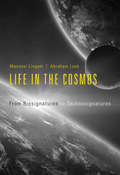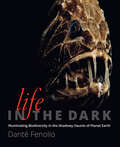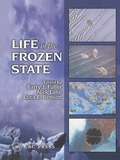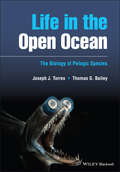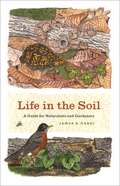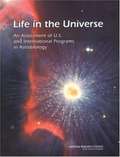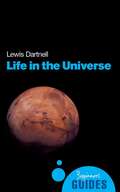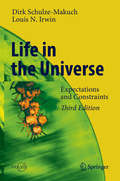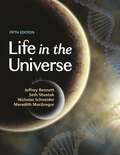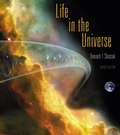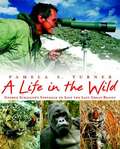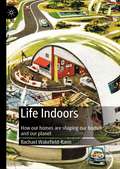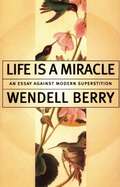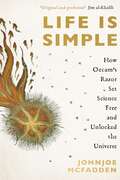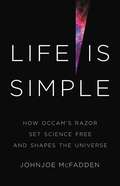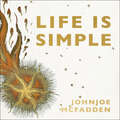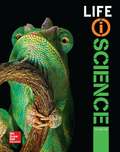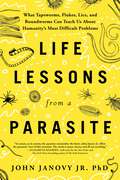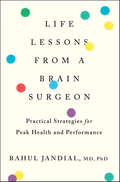- Table View
- List View
Life in the Cosmos: From Biosignatures to Technosignatures
by Avi Loeb Manasvi LingamA rigorous and scientific analysis of the myriad possibilities of life beyond our planet. “Are we alone in the universe?” This tantalizing question has captivated humanity over millennia, but seldom has it been approached rigorously. Today the search for signatures of extraterrestrial life and intelligence has become a rapidly advancing scientific endeavor. Missions to Mars, Europa, and Titan seek evidence of life. Laboratory experiments have made great strides in creating synthetic life, deepening our understanding of conditions that give rise to living entities. And on the horizon are sophisticated telescopes to detect and characterize exoplanets most likely to harbor life. Life in the Cosmos offers a thorough overview of the burgeoning field of astrobiology, including the salient methods and paradigms involved in the search for extraterrestrial life and intelligence. Manasvi Lingam and Abraham Loeb tackle three areas of interest in hunting for life “out there”: first, the pathways by which life originates and evolves; second, planetary and stellar factors that affect the habitability of worlds, with an eye on the biomarkers that may reveal the presence of microbial life; and finally, the detection of technological signals that could be indicative of intelligence. Drawing on empirical data from observations and experiments, as well as the latest theoretical and computational developments, the authors make a compelling scientific case for the search for life beyond what we can currently see. Meticulous and comprehensive, Life in the Cosmos is a master class from top researchers in astrobiology, suggesting that the answer to our age-old question is closer than ever before.
Life in the Dark: Illuminating Biodiversity in the Shadowy Haunts of Planet Earth
by Danté FenolioStunning, never-before-seen photographs of creatures that live in complete darkness.Honorable Mention for Technical Text of the Washington PublishersDeep inside caves, at the bottoms of oceans and lakes, beneath the ground: these concealed habitats are absent of sunlight. This strange and fascinating world of complete darkness is not a solitary place—it is inhabited by millions of life forms. Yet most humans—creatures of daylight—have never seen any of them. Until now. In this fascinating—sometimes eerie—book, extreme wildlife photographer and scientist Danté Fenolio brings the denizens of these shadowy haunts into focus. Life in the Dark shows us the many ways in which life forms have adapted to lightless environments, including refinements of senses, evolution of unique body parts, and illumination using "biological flashlights." With more than 200 mesmerizing color photographs, Life in the Dark unveils bizarre creatures like the firefly squid, the giant Amazonian catfish, the Chinese cavefish, and even the human bot fly, which lives in the darkness beneath its host’s skin. Fenolio’s rich and vibrant images shed new light on the world’s fascinating creatures of darkness.
Life in the Dark: Illuminating Biodiversity in the Shadowy Haunts of Planet Earth
by Danté FenolioAn extreme wildlife photographer explores the bizarre species that thrive in complete darkness with more than 200mesmerizing color photos.Deep inside caves, at the bottoms of oceans and lakes, beneath the ground: these concealed habitats are absent of sunlight, and yet full of life. This strange world of complete darkness is inhabited by millions of life forms that most humans have never seen. Now Danté Fenolio brings the denizens of these shadowy haunts into focus. Life in the Dark shows us the many ways in which life forms have adapted to lightless environments, including refinements of senses, evolution of unique body parts, and illumination using “biological flashlights.”Discover fascinating creatures like the firefly squid, the giant Amazonian catfish, the Chinese cavefish, and even the human bot fly, which lives in the darkness beneath its host’s skin. Fenolio’s rich and vibrant images shed new light on the world’s fascinating creatures of darkness.
Life in the Frozen State
by Barry J. Fuller Nick Lane Erica E. BensonWhile it is barely 50 years since the first reliable reports of the recovery of living cells frozen to cryogenic temperatures, there has been tremendous growth in the use of cryobiology in medicine, agriculture, horticulture, forestry, and the conservation of endangered or economically important species.As the first major text on cryobiolog
Life in the Himalaya: An Ecosystem at Risk
by Maharaj K. PanditThe collision of the Indian and Eurasian plates 50 million years ago created the Himalaya, along with massive glaciers, intensified monsoon, turbulent rivers, and an efflorescence of ecosystems. Today, the Himalaya is at risk of catastrophic loss of life. Maharaj Pandit outlines the mountain’s past in order to map a way toward a sustainable future.
Life in the Open Ocean: The Biology of Pelagic Species
by Joseph J. Torres Thomas G. BaileyLife in the Open Ocean Life in the Open Ocean: The Biology of Pelagic Species provides in-depth coverage of the different marine animal groups that form the communities inhabiting the ocean’s pelagic realm. This comprehensive resource explores the physical environment, foraging strategies, energetics, locomotion, sensory mechanisms, global and vertical distributions, special adaptations, and other characteristics of a wide array of marine taxa. Bringing together the most recent information available in a single volume, authors Joseph J. Torres and Thomas G. Bailey cover the Cnidaria (stinging jellies), the ctenophores (comb jellies), pelagic nemerteans, pelagic annelids, crustaceans, cephalopods and pelagic gastropods, invertebrate chordates, as well as micronektonic and larger fishes such as sharks, tunas, mackerels, and mahi-mahi. Detailed chapters on each pelagic group describe internal and external anatomy, classification and history, feeding and digestion, bioluminescent systems and their function, reproduction and development, respiration, excretion, nervous systems, and more. The first book of its kind to address all of the major animal groups comprising both the swimmers and drifters of the open sea, this important resource: Explains how different animals have adapted to live in the open-ocean environment Covers all sensory mechanisms of animals living in the pelagic habitat, including photoreception, mechanoreception, and chemoreception Treats the diverse micronekton assemblage as a community Includes a thorough introduction to the physical oceanography and properties of water in the pelagic realm Life in the Open Ocean: The Biology of Pelagic Species is an excellent senior-level undergraduate and graduate textbook for courses in biology and biological oceanography, and a valuable reference for all those with interest in open-ocean biology.
Life in the Rain Forest
by Christine A. CaputoLearn more about rain forests, and the unique plants and animals that live in them.
Life in the Soil: A Guide for Naturalists and Gardeners
by James B. NardiLeonardo da Vinci once mused that "we know more about the movement of celestial bodies than about the soil underfoot," an observation that is as apt today as it was five hundred years ago. The biological world under our toes is often unexplored and unappreciated, yet it teems with life. In one square meter of earth, there lives trillions of bacteria, millions of nematodes, hundreds of thousands of mites, thousands of insects and worms, and hundreds of snails and slugs. But because of their location and size, many of these creatures are as unfamiliar and bizarre to us as anything found at the bottom of the ocean. Life in the Soil invites naturalists and gardeners alike to dig in and discover the diverse community of creatures living in the dirt below us. Biologist and acclaimed natural history artist James B. Nardi begins with an introduction to soil ecosystems, revealing the unseen labors of underground organisms maintaining the rich fertility of the earth as they recycle nutrients between the living and mineral worlds. He then introduces readers to a dazzling array of creatures: wolf spiders with glowing red eyes, snails with 120 rows of teeth, and 10,000-year-old fungi, among others. Organized by taxon, Life in the Soil covers everything from slime molds and roundworms to woodlice and dung beetles, as well as vertebrates from salamanders to shrews. The book ultimately explores the crucial role of soil ecosystems in conserving the worlds above and below ground. A unique and illustrative introduction to the many unheralded creatures that inhabit our soils and shape our environment above ground, Life in the Soil will inform and enrich the naturalist in all of us.
Life in the Soil: A Guide for Naturalists and Gardeners
by James B. NardiLeonardo da Vinci once mused that “we know more about the movement of celestial bodies than about the soil underfoot,” an observation that is as apt today as it was five hundred years ago. The biological world under our toes is often unexplored and unappreciated, yet it teems with life. In one square meter of earth, there lives trillions of bacteria, millions of nematodes, hundreds of thousands of mites, thousands of insects and worms, and hundreds of snails and slugs. But because of their location and size, many of these creatures are as unfamiliar and bizarre to us as anything found at the bottom of the ocean. Lavishly illustrated with nearly three hundred color illustrations and masterfully-rendered black and white drawings throughout, Life in the Soil invites naturalists and gardeners alike to dig in and discover the diverse community of creatures living in the dirt below us. Biologist and acclaimed natural history artist James B. Nardibegins with an introduction to soil ecosystems, revealing the unseen labors of underground organisms maintaining the rich fertility of the earth as they recycle nutrients between the living and mineral worlds. He then introduces readers to a dazzling array of creatures: wolf spiders with glowing red eyes, snails with 120 rows of teeth, and 10,000-year-old fungi, among others. Organized by taxon, Life in the Soil covers everything from slime molds and roundworms to woodlice and dung beetles, as well as vertebrates from salamanders to shrews. The book ultimately explores the crucial role of soil ecosystems in conserving the worlds above and below ground. A unique and illustrative introduction to the many unheralded creatures that inhabit our soils and shape our environment aboveground, Life in the Soil will inform and enrich the naturalist in all of us.
Life in the Universe: An Assessment of U.S. and International Programs in Astrobiology
by Committee on the Origins Evolution Of LifeAn Assessment of U.S. and International Programs in Astrobiology
Life in the Universe: A Beginner's Guide (Beginner's Guides)
by Lewis DartnellAstrobiology, the study of life and its existence in the universe, is now one of the hottest areas of both popular science and serious academic research, fusing biology, chemistry, astrophysics, and geology. In this masterful introduction, Lewis Dartnell explores its latest findings, and explores some of the most fascinating questions in science. What actually is 'life'? Could it exist on other planets? Could alien cells be based on silicon rather than carbon, or need ammonia instead of water? Introducing some of the most extreme lifeforms on Earth - those thriving in boiling acid or huddled around deep-sea volcanoes - Dartnell takes us on a tour of the universe to reveal how deeply linked we are to our cosmic environment, and shows why the Earth is so uniquely suited for the development of life.
Life in the Universe: Expectations and Constraints (Springer Praxis Books)
by Dirk Schulze-Makuch Louis N. IrwinExamines each of these parameters in crucial depth and makes the argument that life forms we would recognize may be more common in our solar system than many assume. Considers exotic forms of life that would not have to rely on carbon as the basic chemical element, solar energy as the main energy source, or water as the primary solvent and the question of detecting bio- and geosignatures of such life forms, ranging from earth environments to deep space. Seeks an operational definition of life and investigate the realm of possibilities that nature offers to realize this very special state of matter. Avoids scientific jargon wherever possible to make this intrinsically interdisciplinary subject understandable to a broad range of readers.
Life in the Universe, 5th Edition
by Jeffrey Bennett Seth Shostak Nicholas Schneider Meredith MacGregorThe world’s leading textbook on astrobiology—ideal for an introductory one-semester course and now fully revised and updatedAre we alone in the cosmos? How are scientists seeking signs of life beyond our home planet? Could we colonize other planets, moons, or even other star systems? This introductory textbook, written by a team of four renowned science communicators, educators, and researchers, tells the amazing story of how modern science is seeking the answers to these and other fascinating questions. They are the questions that are at the heart of the highly interdisciplinary field of astrobiology, the study of life in the universe.Written in an accessible, conversational style for anyone intrigued by the possibilities of life in the solar system and beyond, Life in the Universe is an ideal place to start learning about the latest discoveries and unsolved mysteries in the field. From the most recent missions to Saturn’s moons and our neighboring planet Mars to revolutionary discoveries of thousands of exoplanets, from the puzzle of life’s beginning on Earth to the latest efforts in the search for intelligent life elsewhere, this book captures the imagination and enriches the reader’s understanding of how astronomers, planetary scientists, biologists, and other scientists make progress at the cutting edge of this dynamic field. Enriched with a wealth of engaging features, this textbook brings any citizen of the cosmos up to speed with the scientific quest to discover whether we are alone or part of a universe full of life.An acclaimed text designed to inspire students of all backgrounds to explore foundational questions about life in the cosmosCompletely revised and updated to include the latest developments in the field, including recent exploratory space missions to Mars, frontier exoplanet science, research on the origin of life on Earth, and moreEnriched with helpful learning aids, including in-chapter Think about It questions, optional Do the Math and Special Topic boxes, Movie Madness boxes, end-of-chapter exercises and problems, quick quizzes, and much moreSupported by instructor’s resources, including an illustration package and test bank, available upon request
Life in the Universe, 5th Edition
by Jeffrey Bennett Seth Shostak Nicholas Schneider Meredith MacGregorThe world’s leading textbook on astrobiology—ideal for an introductory one-semester course and now fully revised and updatedAre we alone in the cosmos? How are scientists seeking signs of life beyond our home planet? Could we colonize other planets, moons, or even other star systems? This introductory textbook, written by a team of four renowned science communicators, educators, and researchers, tells the amazing story of how modern science is seeking the answers to these and other fascinating questions. They are the questions that are at the heart of the highly interdisciplinary field of astrobiology, the study of life in the universe.Written in an accessible, conversational style for anyone intrigued by the possibilities of life in the solar system and beyond, Life in the Universe is an ideal place to start learning about the latest discoveries and unsolved mysteries in the field. From the most recent missions to Saturn’s moons and our neighboring planet Mars to revolutionary discoveries of thousands of exoplanets, from the puzzle of life’s beginning on Earth to the latest efforts in the search for intelligent life elsewhere, this book captures the imagination and enriches the reader’s understanding of how astronomers, planetary scientists, biologists, and other scientists make progress at the cutting edge of this dynamic field. Enriched with a wealth of engaging features, this textbook brings any citizen of the cosmos up to speed with the scientific quest to discover whether we are alone or part of a universe full of life.An acclaimed text designed to inspire students of all backgrounds to explore foundational questions about life in the cosmosCompletely revised and updated to include the latest developments in the field, including recent exploratory space missions to Mars, frontier exoplanet science, research on the origin of life on Earth, and moreEnriched with helpful learning aids, including in-chapter Think about It questions, optional Do the Math and Special Topic boxes, Movie Madness boxes, end-of-chapter exercises and problems, quick quizzes, and much moreSupported by instructor’s resources, including an illustration package and test bank, available upon request
Life in the Universe (Third Edition)
by Jeffrey O. Bennett Seth ShostakLife in the Universe takes non-science majors on a journey through the solar system and beyond, using a rigorous yet accessible introduction to astronomy, biology, and geology to explain natural phenomena and to explore profound scientific questions about astrobiology. The Third Edition has been thoroughly revised to include updated scientific discoveries, new Cosmic Context two-page spreads, and an updated Companion Website. Designed for astrobiology courses but also suitable for introductory astronomy courses, Life in the Universe captures your imagination by exploring fundamental pan-scientific questions: What is life? How did life begin on Earth? What are the most extreme forms of life currently known? Is it reasonable to imagine life beyond Earth? The text motivates you to develop basic reasoning skills and an understanding of the process of science through skillful writing and a wealth of pedagogical features, such as Learning Goals that keep you focused on key concepts. Sidebars provide optional mathematical material for courses that fulfill quantitative requirements.
A Life in The Wild: George Schaller's Struggle to Save the Last Great Beasts
by Pamela S. TurnerIn this biography, Pamela S. Turner examines the amazing life and groundbreaking work of the man International Wildlife calls the worlds foremost field biologist. Schaller's landmark research revolutionized field biology, demonstrating that it is possible to study dangerous animals in their own habitats: mountain gorillas in Central Africa, predatory tigers in India, mysterious snow leopards in the Himalayas, and many others.
Life Indoors: How our homes are shaping our bodies and our planet
by Rachael Wakefield-RannIn this timely and expansive book, Wakefield-Rann investigates how emerging disease ecologies are undermining definitions of health and immunity that have persisted since the 19th century, and had a formative influence over the design of not only homes, but entire cities. This wide-ranging account traces the links between the history of medicine, modernist design and architecture, the rise of inflammatory disease, the microbiomes of buildings and humans, antimicrobial resistance, and novel chemical pollutants, to show how indoor environments have made us as we have made them. In highlighting the processes that have been missed in designing perfectly controlled interior habitats, Life Indoors shows the limitations of dominant practices, classifications and philosophies to apprehend current indoor pathogen ecologies.
Life Is a Miracle: An Essay Against Modern Superstition
by Wendell BerryActually consisting of a set of wide-ranging, sentimental essays in which farmer, poet and writer Wendell Berry argues for greater dialogue between the arts and sciences, attempts to show that E.O. Wilson's "Consilience" is no more than the subjugation of religion and art by science, and advocates a new "emancipation proclamation" to free people from enslavement by corporations.
Life is Simple: How Occam's Razor Set Science Free And Unlocked the Universe
by JohnJoe McFaddenLife is Simple tells the remarkable story of how a thirteenth century monk's search for simplicity led to the emergence of the modern world.We begin in the turbulent times of the medieval friar, William of Occam, who first articulated the principle that the best answer to any problem is the simplest. This theory, known as Occam's razor, cut through the thickets of medieval metaphysics to clear a path for modern science. We follow the razor in the hands of the giants of science, from Copernicus, to Kepler, Galileo, Newton, Darwin, Einstein, Rubin and Higgs. Its success suggests that we live in the simplest possible habitable universe and supports the revolutionary theory that our cosmos has evolved.By highlighting the very human passion, curiosity, mistakes and struggles of those who were inspired by Occam's razor to create the modern world, Johnjoe McFadden provides new insight into what science is really about. And that the principle of simplicity is as relevant today as ever..
Life Is Simple: How Occam's Razor Set Science Free and Shapes the Universe
by Johnjoe McFadden"In short, Life Is Simple is enthralling."--Michael Blastland, ProspectA biologist argues that simplicity is the guiding principle of the universe Centuries ago, the principle of Ockham&’s razor changed our world by showing simpler answers to be preferable and more often true. In Life Is Simple, scientist Johnjoe McFadden traces centuries of discoveries, taking us from a geocentric cosmos to quantum mechanics and DNA, arguing that simplicity has revealed profound answers to the greatest mysteries. This is no coincidence. From the laws that keep a ball in motion to those that govern evolution, simplicity, he claims, has shaped the universe itself. And in McFadden&’s view, life could only have emerged by embracing maximal simplicity, making the fundamental law of the universe a cosmic form of natural selection that favors survival of the simplest. Recasting both the history of science and our universe&’s origins, McFadden transforms our understanding of ourselves and our world.
Life is Simple: How Occam's Razor Set Science Free And Unlocked the Universe
by JohnJoe McFaddenLife is Simple tells the remarkable story of how a thirteenth century monk's search for simplicity led to the emergence of the modern world.We begin in the turbulent times of the medieval friar, William of Occam, who first articulated the principle that the best answer to any problem is the simplest. This theory, known as Occam's razor, cut through the thickets of medieval metaphysics to clear a path for modern science. We follow the razor in the hands of the giants of science, from Copernicus, to Kepler, Galileo, Newton, Darwin, Einstein, Rubin and Higgs. Its success suggests that we live in the simplest possible habitable universe and supports the revolutionary theory that our cosmos has evolved.By highlighting the very human passion, curiosity, mistakes and struggles of those who were inspired by Occam's razor to create the modern world, Johnjoe McFadden provides new insight into what science is really about. And that the principle of simplicity is as relevant today as ever.(P) 2021 Hodder & Stoughton Limited
Life Lessons from a Parasite: What Tapeworms, Flukes, Lice, and Roundworms Can Teach Us About Humanity's Most Difficult Problems
by John Janovy Jr. PhD"In nature, as in society, the parasites outnumber the hosts. John Janovy Jr. offers the parasites' view of this situation. The result is smart, funny, and all too revealing." – Elizabeth Kolbert, staff writer for The New Yorker and New York Times bestselling author of The Sixth ExtinctionThe answers to life's biggest questions can be found by looking at the little things… Though you may not be able to see them with the naked eye, parasites—miniscule life forms that live inside other organisms—inhabit our everyday lives. From headlice to bird droppings, litterboxes to unfiltered water, you have brushed up against the most common way of life on our planet.In this unique book, John Janovy Jr., one of the world's preeminent experts on parasites, reveals what can humans learn from the most reviled yet misunderstood animals on Earth: lice, tapeworms, flukes, and maggots that can eat a lizard from the inside, and how these lessons help us negotiate our own complicated world. Whether we're learning to adapt to adverse conditions, accept our own limitations, or process new information in an ever-changing landscape—we can be sure a parasite did it first. At once peculiar and profound, Life Lessons from a Parasite makes a case for using knowledge of the natural world, with all its wonderful mysteries and quirks, to tackle our worst problems.
Life Lessons From A Brain Surgeon: Practical Strategies for Peak Health and Performance
by Rahul JandialWith cutting-edge science and colorful anecdotes, a neurosurgeon reveals how to boost your mental performance and creativity in everyday life. From performing risky surgeries to leading innovative research, Dr. Rahul Jandial is at the very forefront of neuroscience. In this fascinating book, he draws on his wide-ranging expertise to explain the bigger picture of brain health and rejuvenation. Taking readers from the operating room and the lab to surgical missions around the world, Dr. Jandial introduces the latest breakthroughs in neuroscience—and explains how this incredible knowledge can be applied to everyday life. Busting myths along the way, Jandial helps readers get wired for success at work and school, perform better when the pressure is on, boost memory, control stress and emotions, minimize pain, stick to a healthy eating plan, unleash creativity, raise smarter kids, and stay sharp as they age. Combining the treatment guidelines he gives his patients, the most promising concepts from frontier science, and the smartest super-achiever hacks, Dr. Jandial provides practical takeaways for optimizing brain function and leading a healthier, happier, more productive life.Previously published under the title Neurofitness.
